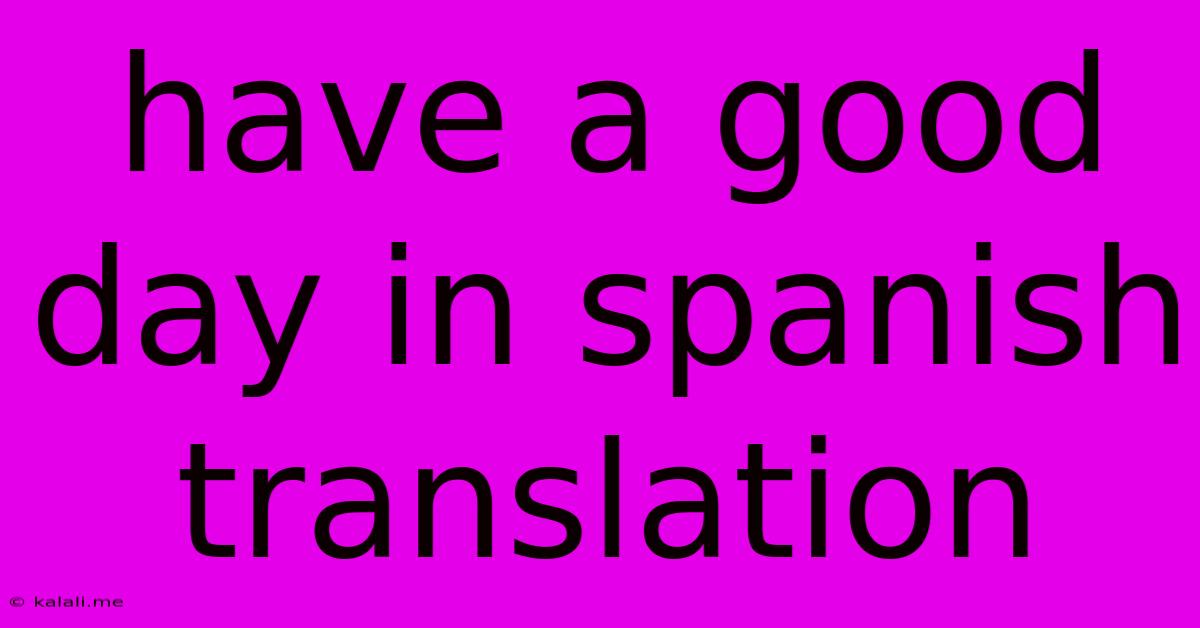Have A Good Day In Spanish Translation
Kalali
Jun 11, 2025 · 3 min read

Table of Contents
Saying "Have a Good Day" in Spanish: More Than Just a Simple Translation
Want to wish someone a wonderful day in Spanish? While a simple translation might seem sufficient, there's a rich tapestry of ways to express this sentiment, each carrying a slightly different nuance and level of formality. This article will delve into the various ways to say "Have a good day" in Spanish, helping you choose the perfect phrase for any situation. We'll also explore some related expressions and cultural considerations to ensure your message resonates authentically.
Common Ways to Say "Have a Good Day" in Spanish:
The most straightforward translation of "Have a good day" is "Que tengas un buen día." This is a perfectly acceptable and widely understood phrase, suitable for most casual situations. However, depending on the time of day and your relationship with the person, other options might be more appropriate.
-
Morning: For the morning, you could say "Que tengas un buen día" or opt for the more specific "Que tengas un buen mañana" (Have a good morning).
-
Afternoon: In the afternoon, "Que tengas una buena tarde" (Have a good afternoon) is a suitable choice.
-
Evening: For the evening, use "Que tengas una buena noche" (Have a good night/evening). This is often used as a farewell, even if it's still relatively early in the evening.
-
Formal vs. Informal: The phrases above are generally suitable for both formal and informal settings. However, a more formal option might be "Le deseo que tenga un buen día" (I wish you have a good day), which is more polite and respectful, especially when addressing someone of higher authority or someone you don't know well.
Beyond the Basics: Adding Nuance to Your Greeting
You can add a personal touch and enhance the meaning by incorporating these variations:
- Que tengas un excelente día: (Have an excellent day) - Expresses a stronger wish for a truly wonderful day.
- Que tengas un bonito día: (Have a beautiful day) - Focuses on the pleasant aspects of the day.
- Que pase un buen día: (Have a good day) - This is a slightly more formal and less common variation than "Que tengas un buen día". It uses the formal "usted" form but doesn't require the "usted" pronoun as the verb conjugation already indicates formality.
- ¡Que tengas un gran día!: (Have a great day!) - This is a more enthusiastic and informal version. The exclamation point adds emphasis.
Cultural Considerations:
While these phrases are widely understood, remember that cultural context matters. In Spain, for example, greetings and farewells are often more elaborate than in some other Spanish-speaking countries. Don't be surprised if you receive a more detailed response than a simple "Gracias" (Thank you).
Conclusion:
Mastering the art of saying "Have a good day" in Spanish extends beyond simple translation. By understanding the nuances of different phrases and their appropriateness in various contexts, you'll be able to communicate your well-wishes effectively and authentically. So, choose the phrase that best suits the situation and leave a lasting positive impression. Remember to practice and use these phrases in context to improve your fluency and confidence in the language.
Latest Posts
Latest Posts
-
Average Sat For San Diego State
Jun 12, 2025
-
What Is The Symbol Of Tungsten
Jun 12, 2025
-
In Parallelogram Abcd What Is Dc
Jun 12, 2025
-
What Is The Major Product Formed In The Following Reaction
Jun 12, 2025
-
Which Of The Following Is Included In Gdp
Jun 12, 2025
Related Post
Thank you for visiting our website which covers about Have A Good Day In Spanish Translation . We hope the information provided has been useful to you. Feel free to contact us if you have any questions or need further assistance. See you next time and don't miss to bookmark.